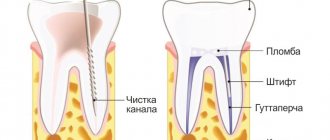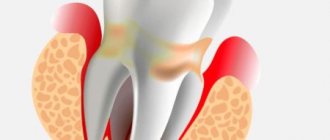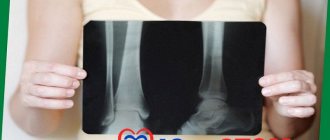Modern dental clinics provide their patients with such a service as hemisection of the tooth. We are talking about an extremely responsible and technically complex operation. Its result is the removal of the root of a tooth damaged by a cyst or granuloma. Moreover, only one root is amputated. The pathological neoplasm is excised along with it. The remaining roots are kept intact.
Indications
Hemisection is possible only in relation to multi-rooted teeth of the lower jaw, in situations where the source of inflammation is not accessible for treatment by non-surgical methods. At the same time, the other canals of the tooth must be healthy or subject to standard medical procedures. The main indications are:
- periodontitis resulting from chronic infection;
- intraosseous pockets in the root area;
- vertical split of a molar;
- deep caries;
- structural anomalies;
- dental granuloma;
- infections introduced after poor-quality canal treatment.
The operation is performed on children and adolescents, which is preferable to complete tooth extraction, since implantation is possible after 25 years, when skeletal growth is completed.
Application of the technique in dentistry
The surgical technique is used by specialists in the following cases:
- if surgical treatment is necessary for adolescents. Tooth extraction can negatively affect the formation of the bite;
- hemisection is used to eliminate a tumor located in close proximity to the root. The use of the technique allows you to excise only the pathological area without affecting healthy tissue;
- removal of only one root will solve the problem of treating its fracture and preserve the healthy part of the organ;
- root amputation using hemisection allows you to eliminate long-term infectious inflammation of surrounding tissues, which cannot be treated by other methods;
- surgery may be required to eliminate the purulent focus. If an accumulation of inflammatory fluid has formed in one of the roots, it is not necessary to remove the entire organ to remove it; it is enough to perform a hemisection;
- in some cases, it is impossible to cure the carious process by cleaning and filling all root canals due to their complex anatomical structure. This circumstance especially concerns narrow root canals. In this case, surgical intervention will help eliminate the pathological process - excision of the root and part of the crown;
- hemisection of a tooth is the most gentle way out of a situation when it is necessary to remove a dental instrument stuck in the root canal.
Contraindications
Resection is not performed in old age and in patients with severe systemic pathologies: diabetes mellitus, blood diseases, cardiovascular disorders in the acute stage. Also, surgery is not prescribed for infectious processes and disorders of the immune system. In addition, contraindications are:
- fused roots;
- destruction of bone tissue around the affected dental unit;
- obstruction of the root canals intended for preservation;
- stomatitis.
It should be noted that a tendency to allergies is not a contraindication, since modern pharmacology offers a wide selection of anesthetics for any clinical case.
Restrictions on the use of the procedure
The hemisection procedure is not used in some cases when the benefit of the intervention is not comparable to the risk to the patient. The cause of failure may be problems with blood clotting. In addition, individual intolerance to drugs and local anesthesia can become a significant obstacle to performing the operation. It is undesirable to carry out the intervention during periods of exacerbation of chronic diseases, such as diabetes mellitus and chronic heart failure.
An obstacle to intervention may be the anatomical structure of the affected tooth:
- location of the roots in close proximity to the maxillary sinus. In this case, the operation of hemisection of the tooth is fraught with damage to the bone walls of the sinus and the occurrence of an inflammatory process in it (sinusitis);
- a tooth whose roots cannot be separated due to fusion cannot be subjected to hemisection;
- too much destruction of the crown. In this case, after the operation there will be a small part of the organ that cannot cope with the load;
- an organ with too short roots may fall out after hemisection. In this situation, intervention is not recommended.
- deficiency of soft gum tissue at the site of the proposed intervention. They may not be enough to close the resulting wound after the procedure.
Preparing for amputation
Resection of a part of the tooth is carried out after preliminary preparation, including collection of a medical history, instrumental diagnostics, consultations with an orthopedist and other doctors of related specialties. Surgical intervention is preceded by complete sanitation of the oral cavity and conservative treatment, during which the dentist cleans and fills healthy root canals. At the end of the manipulations, a control x-ray is taken.
The appointment includes consultation and drawing up a treatment plan with cost determination
sign up for a free consultation
Not ready for an in-person consultation with a doctor? Ask your question by phone
Cost of services
Consultation with an implant surgeon 0 rub.
Hemisection 2,500 rub.
Expert of the article you are reading:
Lyubomskaya Olesya Alekseevna
Dental surgeon-implantologist, dental therapist, dentist - orthopedist (K.M.N.) (Candidate of Medical Sciences).
You may also be interested in:
Wisdom tooth removal Tooth extraction Removal of the dental nerve Complex tooth extraction Resection of the apex of the tooth root Removal of an impacted tooth Removal of the tooth root Removal of a dystopic tooth
Show more
Basic methods and stages of surgical treatment
The partial resection operation meets modern dental requirements aimed at preserving the patient’s own teeth without discomfort and pain. There are two main methods of hemisection.
- The first option is removal from above. During the operation, vertical sawing and amputation of a segment of the coronal part of the tooth is performed along with the affected root and tissues affected by inflammation. The resulting hole is filled with osteoplastic material. To restore the tooth crown, a pin is installed, and if necessary, the surgeon sutures the mucous membrane.
- The patch hemisection technique is indicated in cases where the tooth crown is not destroyed, but the root cannot be restored. Access to the affected area is carried out by detaching a gum flap, after which the damaged part of the root is amputated. At the end of the hemisection, the excised tissue is placed in place and sutured with catgut threads. If the remaining part of the crown is mobile, splinting is used.
Very often, to speed up wound healing, instead of osteoplastic mass, blood plasma is transplanted into the socket. The innovative technique eliminates the risk of rejection and significantly speeds up the recovery process. During the operation, radiography and follow-up examinations are required. Healing takes up to four months, after which the healthy part of the molar can be used as a full-fledged support for the installation of an orthopedic structure.
Advantages and disadvantages of the method
Like any method of treating a disease, hemisection of a tooth has its positive and negative sides.
The main advantages include the following:
- hemisection retains the ability to use the diseased organ as a basis for subsequent prosthetics;
- the operation will avoid the appearance of free space in the dentition and the movement of other teeth;
- the preserved part of the organ will participate in chewing food, which will evenly distribute the load on the jaw;
- the remaining part of the organ after hemisection of the root will allow the bone and supporting components of the jaw (such as the alveolar ligament) to continue to be included in the work. In the absence of roots, a process of loss of bone density occurs - atrophy;
- hemisection can be used both in adults and in adolescents whose bite and dentition have not yet fully formed;
- the use of local anesthesia and the absence of large incisions makes root amputation by hemisection a safe procedure associated with the development of a minimum of complications.
While there are positive aspects to the hemisection method, there are also disadvantages. A significant circumstance is the loss of part of the crown and one root. Ultimately, such a defect becomes the reason that the tooth will not be able to withstand the normal load that falls on it during the chewing process. In addition, unprofessional assistance provided and failure to comply with doctor’s recommendations in the postoperative period can lead to complications.
Possible complications
Innovative equipment, highly qualified doctors and the introduction of new techniques provide positive treatment prognoses even in the most difficult cases. Despite this, it should be understood that any surgical intervention entails risks of complications. After the operation the following are possible:
- general malaise and increased body temperature;
- loss of appetite;
- swelling and pain in the operated area;
- exacerbation of concomitant pathologies;
- violation of fixation of the remaining part of the dental crown.
In difficult cases, the patient may be sent to a hospital and prescribed complex drug treatment with antibacterial, anti-inflammatory and immunomodulatory drugs. In rare cases, a second operation may be required to remove the remaining part of the tooth.
What is the price of hemisection of a tooth?
The cost of hemisection surgery may vary based on the price segment of the dental clinic, the qualifications of specialists and the level of complexity of the work in a particular case. The price of hemisection of a tooth in Moscow clinics will range from 2 to 7 thousand rubles. However, when calculating the amount for treatment, the patient must take into account that, in addition to the operation itself, it will require a doctor’s consultation, X-ray diagnostics (before the operation, immediately after it and a month later), possibly a computed tomography. Only the attending physician can plan the exact cost of treatment, taking into account the indication for hemisection of the tooth, the patient’s characteristics and other nuances.
Recommendations for rehabilitation
If the patient is aware of an allergy to medications, then to eliminate the risks of complications and a possible negative reaction of the body, the surgeon should be informed. Modern pharmacology allows you to select the most safe anesthetic for the patient’s health.
To speed up the recovery process, you should refrain from eating for two to three hours after surgery. In addition, it is necessary to exclude hard, spicy, too cold or hot foods from the diet. Physical activity and heavy lifting are not recommended for two weeks.
Contraindications and risks of tooth root amputation surgery
Are there complications after tooth root amputation?
With any surgical intervention there is always a risk of some complications. Hemisection of a tooth root is a rather complex operation and should be performed only by qualified specialists using modern dental equipment, using proven drugs of the latest generation.
But, nevertheless, there is a possibility of the following complications occurring after surgery:
- Swelling, redness of the mucous membrane in the surgical area;
- Suture dehiscence, bleeding;
- Wound infection;
- Loosening of the remaining root.
The cause of postoperative complications is most often the presence of pathogenic microflora in the oral cavity, the patient’s weak immunity, poor oral hygiene after surgery, or violation of the recommendations of the attending physician.
What are the contraindications to hemisection of the tooth root?
Contraindications to tooth root amputation are:
- Advanced age;
- Obstruction of canals in the roots that need to be preserved;
- Root fusion;
- Proximity of the maxillary sinuses or mandibular canal;
- Insufficient length of roots (leads to loosening and, subsequently, tooth loss);
- Resorption of bone tissue under a diseased tooth;
- Small amount of gum tissue at the surgical site;
- Intolerance to any type of anesthesia;
- General contraindications for operations.
Advantages of hemisection
Hemisection is recommended mainly because the roots that are then preserved can be used as a support for dentures. This allows prosthetics to be carried out on a support that will not be rejected as a foreign body in the tissues, and as a result, the roots will continue to function for a long time.
In addition, there is no need to get rid of the entire tooth - after cleaning the canals and removing the damaged root, the tooth can be restored or replaced with prosthetics.
An equally important advantage of the operation is the minimal number of complications when compared with the procedure for installing artificial implants in the jaw.
How does the procedure work?
The operation is carried out in several basic steps. The procedure is quite painful, so the first stage will be the administration of local anesthesia or anesthesia. Since the operation sometimes takes a long time, in some clinical cases general anesthesia is required.
After pain relief, the dental surgeon begins to perform hemisection. Operation stages:
- Sawing off the crown in the area where it connects to the root or cutting the gums near the affected tooth;
- Removal of the affected root along with the cyst or granuloma;
- Disinfection of affected tissues, antiseptic treatment.
It is impossible to allow the resulting void after root removal to be overgrown with gum tissue, and therefore the space remaining after root removal is filled with artificial bone compounds, which are covered with a protective membrane. There are cases where the body rejected such tissue, but this happens extremely rarely.
Prosthetics on the upper part of the tooth can be started within a month, if everything has healed normally and there is no inflammation.
Features of postoperative recovery
How rehabilitation will go after hemisection of a tooth largely depends on the patient’s behavior. To prevent the development of complications, the patient should adhere to the recommendations for oral care:
- In the first 2-3 days, do antiseptic baths. After this period has expired, regularly rinse your mouth with an antiseptic mouthwash.
- In the first two days after surgery, avoid brushing the teeth located around the operated area. This is necessary in order not to damage the seams. On the third day, you can try to brush all your teeth with a soft toothbrush using gentle movements.
- After every meal you should rinse your mouth.
- In the first days after the procedure, you are allowed to take painkillers, as pain may normally be present.
- Take antibiotics as prescribed by your doctor. You should not stop taking these medications ahead of schedule.
- Use vitamin complexes, immunostimulants and other auxiliary medications as prescribed by your doctor.
- In the first days after hemisection, avoid physical activity, as well as any thermal procedures (baths, saunas, etc.).
- Until the gum mucosa is completely healed, it is better not to eat food that will irritate soft tissues (too salty, peppery, hot, hard).
- Avoid drinking alcohol and tobacco until the wound is completely healed.











